Chile’s new wave
(by peter)
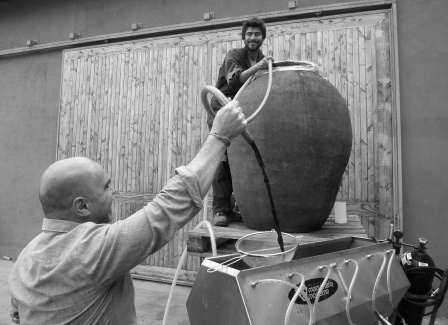 I have a friend in the wine magazine business who says he can summarise pretty much every regional wine feature ever written in one sentence:
I have a friend in the wine magazine business who says he can summarise pretty much every regional wine feature ever written in one sentence:
‘Everything’s getting a little bit better.’
I’m sure I’m as guilty as the next wine writer of such banality, even though I try hard not to. But it just so happens that, writing about Chile, this kind of summary is repetitively appropriate. Especially when you substitute ‘a little bit’ for ‘lots’, add in the words ‘frighteningly fast’ – and maybe change ‘better’ for ‘more interesting’.
The truth is that Chilean wine is changing fast and it takes quite a bit of keeping up with. Where before the industry was dominated by large-scale companies making decent wine, now there is a growing profusion of small-scale, ambitious projects which are daring to challenge the status quo.
People making wine in their front gardens. People reviving oversize earthenware amphorae as winemaking vessels. People growing vines up trees. People making port-style wine ‘for fun’. People making wines in the middle of the driest land desert on earth. Winemakers with mould-breaking ambitions (at least one of whom had a formative experience smuggling grapes from Palestine to make the wine in a Trappist monastery in Israel…)
It’s not surprising that the results can be startling. This was brought home to me at a recent dinner in Santiago.
There were eight of us. An unhealthy mix of winemakers, sommeliers, wine writers, landowners and a restaurateur, together with some delicious meat and 26 bottles of new-wave Chilean wine.
I reproduce some of my tasting notes as below. Although, if I’m honest, at some stage in the evening I stopped trying to take notes and just sat back and soaked it all up.
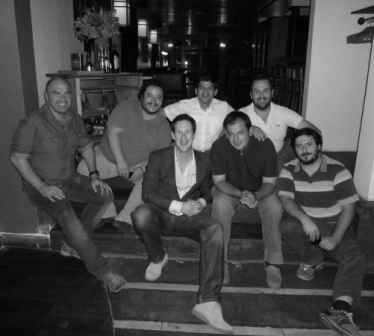 This dinner had a palpable sense of excitement about it. It was as if we were witnessing the dawn of a new era in Chilean wine; there was a whiff of revolution in the air, if that’s not being too grand. (Spanish speakers can read distinguished Chilean journalist Patricio Tapia’s version of events on his blog here, entitled ‘Revolucionarios mal paridos’. He talks of it as, ‘an historic event’, adding: ‘if Chile wants to be taken seriously on the global stage, it needs a band of small producers with their backs to the market and their eyes on their vineyard, their terroir, their vision of wine – or whatever the hell they please… Things are changing fast.’)
This dinner had a palpable sense of excitement about it. It was as if we were witnessing the dawn of a new era in Chilean wine; there was a whiff of revolution in the air, if that’s not being too grand. (Spanish speakers can read distinguished Chilean journalist Patricio Tapia’s version of events on his blog here, entitled ‘Revolucionarios mal paridos’. He talks of it as, ‘an historic event’, adding: ‘if Chile wants to be taken seriously on the global stage, it needs a band of small producers with their backs to the market and their eyes on their vineyard, their terroir, their vision of wine – or whatever the hell they please… Things are changing fast.’)
Many of these wines simply belonged to a different dimension from the established Chilean classics. Instead of ripe fruit, generous structure, perhaps the odd whiff of eucalypt, here were refreshing, resonant wines which delighted in their own simplicity, rusticity, minerality and drinkability.
How to evaluate such wines?
I found myself questioning my own critical parameters. Wines that are big, bold, layered and intense are easy to mark highly. But what of drinkability, food-friendliness, heritage, proud but unadorned authenticity? Surely such values are just as worthy of recognition, even if they might not appeal to all tastes.
Such is the exciting state of modern Chilean wine. The tasting notes below speak for themselves. I’d also point you to my recent profiles of Pedro Parra and Dr Alvaro Peña (I’ll also be posting one on Marcelo Retamal shortly).
Many forward-looking Chilean winemakers now have a new mantra on their lips. It’s winemaking Mies Van der Rohe-style. (This distinguished architect was famous for his dictum: ‘Less is more’.)
Menos es más.
It certainly has a ring to it.
TASTING
- These wines were tasted over a period of a few months in early 2012, both in Chile and in the UK.
WHITES
Ribera del Lago Laberinto Sauvignon Blanc Cenizas de Barlovento 2011, Maule – this personal project by Via winemaker Rafael Tirado represents a different paradigm for Chilean Sauvignon Blanc. Previously, Sauvignons from Curicó and Maule have been largely insipid variations on Sauvignonasse, a dull grape if ever there was one. This is steely, mineral wine grown on the shores of Lake Colbún in the beginnings of the Andean piedmont – a part of Chile relatively unexplored for Sauvignon Blanc. It shows tremendous, almost raw energy and verve. Very punchy, herbal, earthy – rigid purity. One taster described it as, ‘like an arrow’. Give it time. 7-7.5/10
Montes Outer Limits Sauvignon Blanc 2011, Aconcagua Costa – a wine that breaks new viticultural ground for Chile – it’s grown on a farm owned by Montes partner Andres Turner near Zapallar, north of Casablanca. It’s vibrant and tangy, as you might expect from a coastal site, but also impressively persistent and structured. Green bean and lime aromas, elegantly herbal and refreshingly zesty. A bit raw on the finish – perhaps from young vines – but really impressive debut. 7/10
 Bravado Marina Sauvignon Blanc 2011, García-Schwaderer, Casaablanca – dense, crunchy and refreshing. Grapefruit and peach hints. Zingy, rounded, balanced, with good concentration. Very decent Sauvignon. 6.5/10
Bravado Marina Sauvignon Blanc 2011, García-Schwaderer, Casaablanca – dense, crunchy and refreshing. Grapefruit and peach hints. Zingy, rounded, balanced, with good concentration. Very decent Sauvignon. 6.5/10
Calyptra Sauvignon Blanc 2009, Cachapoal, 13%, Cachapoal – like Laberinto, this is another pre-Andean Sauvignon, though in a very different style. Calyptra is high in the Cachapoal piedmont – this parcel is grown close to 900m altitude – and the vineyard produces some outstanding whites. Winemaker François Massoc is a, quiet thoughtful and quite brilliant winemaker who is busy making magic in this prime site (the Aristos and Clos des Fous brands are also sourced partially from here). This Sauvignon is matured in 600-litre French oak barrels for 20 months, never racked, and is quite sumptuous: layered, nutty, elegantly textured and seamless. Very ageworthy. Mineral. Goes beyond just Sauvignon Blanc into ‘outstanding white wine’ territory. (Massoc also showed a 2007 version of this wine, sadly tainted but of which he made one barrel ‘to prove to the owner I could make another style – our only chance as a small winery is to be different,’ he said.) And what a difference. A quite beautiful wine – long, cultured, and without doubt one of the outstanding Chilean whites. The only problem? Just 2,000 litres were made. 8.5-9/10
Morandé Edición Limitada Sauvignon Blanc 2009, Casablanca, 12.5% (£16-18) – very distinctive, very different style for Chilean SB. In texture and aroma, it’s eerily reminiscent of deftly oaked Semillon, with tangerine, honeycomb and roasted lime. Also (believe it or not) goat’s cheese hints. It shows excellent freshness, minerality and breadth. Elegantly textured, persistent. Could have touch more focus and grip but it’s distinctive, refreshingly different. 7/10
Casa Marin Riesling 2009 Miramar vineyard, Lo Abarca, San Antonio, 12.5% – lovely perfumed baked lime and toast nose, wonderful evolution. Rich attack with petrolly notes. Creamy. Lovely appley length. Vibrant but poised, lovely evolution. This was made using old oak barrels and wild yeasts, hence the rich elegant texture. ‘We were scared, the ferment lasted so long, but the wine smelt so good we just kept it there,’ says Felipe Marin. Riesling – especially Chilean Riesling – isn’t an easy sell but my word it’s an undervalued gem (they also make a very creditable sweet version). This one reminds me of top notch dry Austrian Riesling in this style – think Nikolaihof. Beautiful wine, charged with minerality. Wonderful. 8.5/10
Clos des Fous Chardonnay 2010, Cachapoal, 13,8% (c. US$15) – another of Pancho Massoc’s creations, this is a partnership of four members including Pedro Parra. Sourced mainly from Coya, in Alto Cachapoal, with 35% from Requínoa and 15% from Traiguén in Malleco. No oak, no malolactic; left on the lees for 6 months; this is the first vintage. Sensational stuff, great value too. It’s different from almost all other Chilean Chardonnays from the moment you smell it, with its subtle earthy, salty savoury aromas. A complete absence of fruit, a fierce mineral charge, and thrilling acidity allied to textural elegance. Real nobility here, tension and class. Drinkable now, especially with food, but it would benefit from a couple of years in the cellar. Beautiful. 8-8.5/10
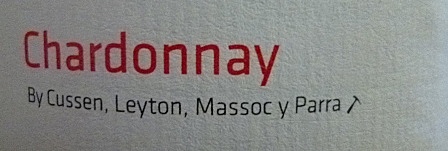 Aristos Duquesa Chardonnay 2009, Cachapoal, 14% – when I rated the 2008 vintage of this wine with an exceptional 20/20 in the pages of Decanter, it caused a stir. People asked me what I was thinking, giving a Chilean Chardonnay a perfect score..? I replied that it was a purely emotional response by Susie and me to a wine that was breath-takingly beguiling, complex and elegant – as close as wine comes to ‘shock and awe’. This vintage is in the same mould – nutty, savoury, layered and beautiful – but has slightly less impressive cohesion and is a touch hot on the finish, perhaps the result of a slightly warmer vintage (or of the barrels being abandoned for three months following the earthquake in 2010, when no access was possible). François Massoc, who makes the wine with fellow Aristos partners Pedro Parra and Burgundian Louis-Michel Ligier-Belair, is a fan of long barrel ageing (what he terms ‘good oxidation’) although he always, ‘listens to the grapes’. 8.5/10
Aristos Duquesa Chardonnay 2009, Cachapoal, 14% – when I rated the 2008 vintage of this wine with an exceptional 20/20 in the pages of Decanter, it caused a stir. People asked me what I was thinking, giving a Chilean Chardonnay a perfect score..? I replied that it was a purely emotional response by Susie and me to a wine that was breath-takingly beguiling, complex and elegant – as close as wine comes to ‘shock and awe’. This vintage is in the same mould – nutty, savoury, layered and beautiful – but has slightly less impressive cohesion and is a touch hot on the finish, perhaps the result of a slightly warmer vintage (or of the barrels being abandoned for three months following the earthquake in 2010, when no access was possible). François Massoc, who makes the wine with fellow Aristos partners Pedro Parra and Burgundian Louis-Michel Ligier-Belair, is a fan of long barrel ageing (what he terms ‘good oxidation’) although he always, ‘listens to the grapes’. 8.5/10
ROSÉ
Zaranda País Cinsault rosé 2011, Guarilihue – young Chilean sommelier Juan Ignacio Acuña’s family have old vines in Guarilihue, 17 kilometres from the ocean in Itata, which were previously sold off for use in basic tetra-pak wines. He brought in François Massoc to consult and the results are some delightfully authentic table wines made for refreshment value and pure quaffing pleasure. The Muscat is scented and succulent; this light rosé is herbal and cherry-scented, with a tangy, juicy finish. 6.5/10
RED
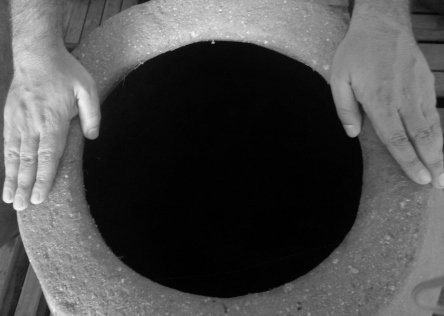 De Martino Viejas Tinajas Cinsault 2011, DO Secano Interior, Coelemu, 12.5% (£8.95, Wine Society) – Beautifully vivacious, laudably audacious wine. Grown in the unfashionable Itata area, 22kms from the sea, from old Cinsault vines (a variety often sidelined for ‘jug’ wine consumption in Chile). Minimal intervention in the winery, no added sulphur, vinified in large earthenware amphorae (tinajas) this is one of Chile’s first ‘natural’ wines. And what a wine. Lively cherry and wild berry fruit with earthy and herbal notes. Strawberry jam. Crushed violets and ganache. Juicy, moreish, nimble, lithe – utterly refreshing. Full of vitality and unadorned appeal. Not super complex but not trying to be: honest joyous upbeat wine. Very well made indeed. I can see why the entire first production of this wine has already sold out. Bravo! This glass represents a really important step forward for Chilean wine. 7/10
De Martino Viejas Tinajas Cinsault 2011, DO Secano Interior, Coelemu, 12.5% (£8.95, Wine Society) – Beautifully vivacious, laudably audacious wine. Grown in the unfashionable Itata area, 22kms from the sea, from old Cinsault vines (a variety often sidelined for ‘jug’ wine consumption in Chile). Minimal intervention in the winery, no added sulphur, vinified in large earthenware amphorae (tinajas) this is one of Chile’s first ‘natural’ wines. And what a wine. Lively cherry and wild berry fruit with earthy and herbal notes. Strawberry jam. Crushed violets and ganache. Juicy, moreish, nimble, lithe – utterly refreshing. Full of vitality and unadorned appeal. Not super complex but not trying to be: honest joyous upbeat wine. Very well made indeed. I can see why the entire first production of this wine has already sold out. Bravo! This glass represents a really important step forward for Chilean wine. 7/10
Montsecano Pinot Noir 2010, Casablanca – a biodynamic project whose partners are local grower Julio Donoso and well known Alsace producer André Ostertag. The seven-hectare vineyard is located near Las Dichas in blustery, cool western Casablanca; the first vintage was 2008. All these factors combine to make a quite wonderful wine – undoubtedly one of Chile’s finest Pinot Noirs. Aromatically it’s subtle, earthy and inviting, with notes of dried herbs and ripe berries. On the palate, it’s beautifully textured, gently bittersweet, with wonderful purity and complexity. Dynamic. Direct. Fruit of the earth – more of a question than an exclamation. One taster describes as smelling, ‘like cocaine, or good Vosne-Romanée’. Be that as it may, this is outstanding Chilean Pinot Noir. 8-8.5/10
Bravado Sofia Pinot Noir 2010, García Schwaderer, Casablanca – big but beautifully crafted style of traditional Chilean Pinot with an elegant, savoury edge. Very sexy, layered and compelling. Lovely stuff. 7.5/10
Tectonia Pinot Noir 2010, Volcanes de Chile, Bio Bio – a real discovery: a lovely balance between freshness and voluptuous charm. Very drinkable. Fluid. Generous, with lovely Pinot architecture, but also refreshing. 7.5/10
Villalobos Viñedo Silvestre Carignan Reserva 2009, Colchagua, 12.9% – artists are used to pushing boundaries so perhaps it’s no surprise that one of the most prominent of Chile’s new-wave wines is made by a sculptor. Enrique Villalobos has a sculpture workshop in Lolol, western Colchagua, and has old vines which, instead of being trained along wires like almost all commercial vineyards, grow wild up trees. The result is about as far from the typically beefy, brawny Colchagua red as it’s possible to get – all floral, earthy, meaty and utterly refreshing in its mid-weight succulence. Sure, it’s a bit edgy (bretty, if you must) but the sheer drinkability and exuberance of this wine is worth saluting. Not to mention drinking. 7/10
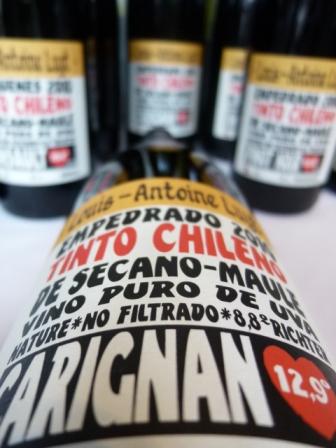 Louis-Antoine Luyt, Carignan ‘Hueva de Triquilemu’ Empedrado 2010, Maule, 12.9% (£12.35, Caves de Pyrene) – this maverick Frenchman is doing exciting things in Chile’s dry-farmed south with varieties like Pinot Noir, Cinsault, País and Carignan. This is a fine, elegantly crafted example of the latter: glossy dark fruit and wild herbal notes coming together in a juicy, earthy, spicy flavour profile. Almost veers into Pinot Noir territory in its gamey red fruit style. Impressive. 7.5/10
Louis-Antoine Luyt, Carignan ‘Hueva de Triquilemu’ Empedrado 2010, Maule, 12.9% (£12.35, Caves de Pyrene) – this maverick Frenchman is doing exciting things in Chile’s dry-farmed south with varieties like Pinot Noir, Cinsault, País and Carignan. This is a fine, elegantly crafted example of the latter: glossy dark fruit and wild herbal notes coming together in a juicy, earthy, spicy flavour profile. Almost veers into Pinot Noir territory in its gamey red fruit style. Impressive. 7.5/10
Ayllu 2010, Salar de Atacama, 14.8% – a unique wine grown from an unidentified field blend in a tiny family vineyard in the middle of the fiercely arid Atacama Desert at breathlessly high altitude. Hardly a commercial prospect, but it proves a point about the adaptability of the vine in almost all corners of Chile. Aomas of earthy, baked berry fruit with chalky hints. Sun-dried flowers. Juicy, berried, quite vivid. Somewhat spirity. But on the palate is where it shows its potential – lovely chalky elegant grip, savoury in style. Lacks real structure and length but, given the circumstances in which it was made, this shows serious potential. The tannins are everything here; they ground the wine and offset the alcohol. A sign of things to come? 6/10
Caviahue 2010, Maipo, 13.5% – family winemaking is undergoing a revival in Chile and this is a brilliant example. Englishman Guy Hooper works for De Martino and lives nearby in the Isla de Maipo. And what better thing to do with his front garden than plant it to vines? The 664 vines (50% Carmenere, 25% Malbec, 24.5% Petit Verdot and 0.5% Syrah) make one barrel of wine. After two years of repose in a cellar next to Guy and Maria José’s dining room, this home-made red is laudably smoky, dense and refreshing. Proper stuff! The 2011, which is mainly Malbec after birds ate the Carmenere, is also creditably floral and juicy. It’s exciting to see home-spun enthusiast wine taking off in Chile. 5.5-6/10
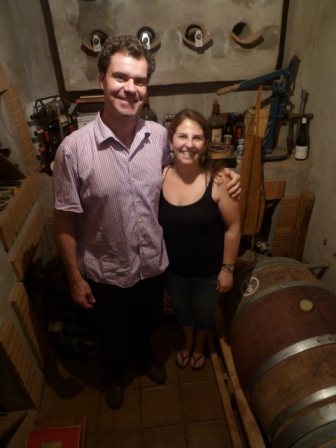 Matetic Coralillo Syrah 2010, San Antonio, 14% – after a flying start, spear-headed by some astoundingly god Syrah, the quality at Matetic has been inconsistent of late. But as of 2012 it’s all change, with winemaker Paula Cardenas leaving, long-time assistant Julio Bastías taking the reins, and Rodrigo Soto returning from California to advise (we reported on visiting him at Benzinger recently). They also have a new vineyard coming on stream – Santo Tomás, just inside Casablanca on north-facing granitic hills, which looks to be an excellent source of scented, structured Syrah. This wine has (so I’m told) 20% Santo Tomás fruit and I’ve been favouring this Coralillo Syrah over the more expensive EQ for some time now – it’s just more vibrant and harmonious. This has punchy meaty floral notes, with a juicy, spicy palate. Fine tannin, spicy finish but lovely succulence and cogency. Still needs work to make it more refreshing but it’s very good. 7.5/10
Matetic Coralillo Syrah 2010, San Antonio, 14% – after a flying start, spear-headed by some astoundingly god Syrah, the quality at Matetic has been inconsistent of late. But as of 2012 it’s all change, with winemaker Paula Cardenas leaving, long-time assistant Julio Bastías taking the reins, and Rodrigo Soto returning from California to advise (we reported on visiting him at Benzinger recently). They also have a new vineyard coming on stream – Santo Tomás, just inside Casablanca on north-facing granitic hills, which looks to be an excellent source of scented, structured Syrah. This wine has (so I’m told) 20% Santo Tomás fruit and I’ve been favouring this Coralillo Syrah over the more expensive EQ for some time now – it’s just more vibrant and harmonious. This has punchy meaty floral notes, with a juicy, spicy palate. Fine tannin, spicy finish but lovely succulence and cogency. Still needs work to make it more refreshing but it’s very good. 7.5/10
Aristos Duque 2008, Grand Cabernet du Chili, 14% – pretty edgy stuff, not my favourite aromas (pretty resinous and minty) but a wonderful flavour profile with fine tannins, beautifully refreshing acidity and a savoury finish. Very pure and direct. Leafy, plummy, peppery. Lovely stuff. Would just prefer less mint! 8/10
And some Vigno wines…
For more background on Vigno, see my previous piece here.
Essentially it’s a group of producers who have banded together to create a brand (in effect a mini-appellation) based around the production of old-vine Carignan in the dry-farmed Maule region.
Below are some highlights from a line-up of twelve Vigno wines we did in Chile. These tend to be big, bold styles of wine, but the best ones are grounded by Carignan’s typically tangy acidity and grippy tannin.
Bravado Vigno Carignan 2009, Melozal, Maule, 14% – quite an edgy, plump style that is relatively restrained in the context and very pleasant. Full of leafy, mashed damson flavours. Made with native yeasts and 18 months in used oak barrels. 7-7.5/10
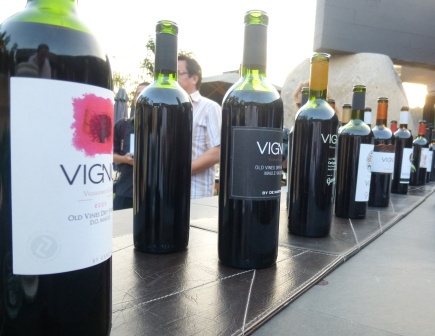 Lomas de Cauquenes Vigno Carignan 2007, Cauquenes, Maule, 13.5% – OK so it’s properly old school, but it is unashamedly rustic, pale (and pretty moreish for it) so I give it the benefit of the doubt. Earthy, leathery and dried red fruits. Has real authenticity and drinkability. 7/10
Lomas de Cauquenes Vigno Carignan 2007, Cauquenes, Maule, 13.5% – OK so it’s properly old school, but it is unashamedly rustic, pale (and pretty moreish for it) so I give it the benefit of the doubt. Earthy, leathery and dried red fruits. Has real authenticity and drinkability. 7/10
Undurraga Vigno Carignan 2010, Sauzal, Maule, 14.6% – includes 12% Cinsault, from Sauzal, native yeasts, old barrels…a very dense and persuasive style. Big but utterly seductive. Inky, glossy, tangy, with fine firm texture. Very accomplished. 7.5/10
Morandé Vigno 2009, Loncomilla, Maule, 15% – both this and the Edición Limitada are impressive Carignans. This one has quite a bit of Syrah (26% in fact) together with, incredibly, 5% Chardonnay. Aged for 30 months in new American oak, with a shade over 15% alcohol, it’s big, bold and effusive – but also brilliantly grounded by tangy red fruit acidity and firm savoury tannins. Spicy, well integrated, with flavours of cream, cassis and dried ink. Lovely wildness to it and lift. Bravo. 7.5-8/10
